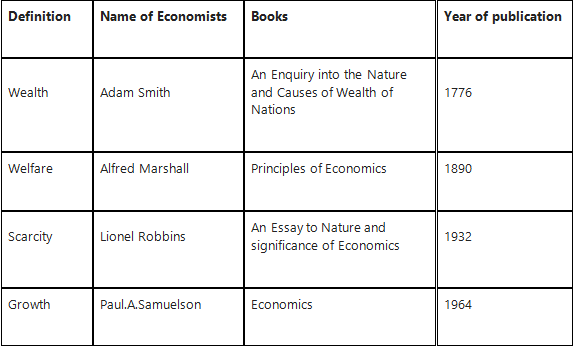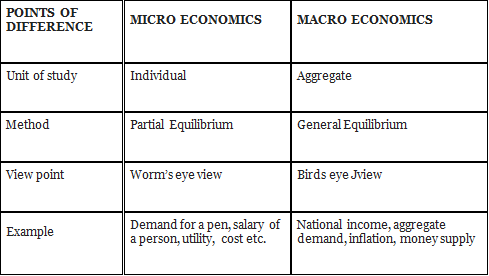Grade 11 Exam > Grade 11 Notes > Economics for Grade 11 > Key Notes - Introduction Micro Economics
Key Notes - Introduction Micro Economics | Economics for Grade 11 PDF Download
Economics:
- The word Economics is derived from the Greek word ‘Oikonomia’ which means ‘household Management’.
- In early days Economics was known as political economy.
- Adam Smith is considered as the father of Economics.
- Alfred Marshall for the first time used the term Economics instead of ‘political economy’.
- The following table shows the important definitions in Economics.

Branches of economics. Economics is broadly dived into two branches. They are the following.
Micro Economics: It is the branch of Economics which deals with individual units.
- It is also called price theory, demand theory, cost theory etc.
Macro Economics: It is another branch of Economics which deals with aggregates.
- John Maynard Keynes is considered as the father of Macro Economics.
- It is otherwise called income theory.
- The main difference between MICRO and MARCO Economics are the following.

Prepare A Seminar Paper on Central Problems of an Economy:
Respected teachers and my dear friends,
The topic of my seminar paper is “central problems of an economy”.
As we know the Central problems of an economy arises due to the following reasons.
- Human wants are unlimited.
- Resources are limited
- Resources have alternative uses. In my seminar paper, I would like to present the Central problems of an economy.
Introduction:
- The resources available to the human are limited, but their wants are unlimited.
- Due to the scarcity of resources, the economy faces the problem of choice.
- This mismatch between unlimited wants and limited resources that gives rise to three Central problems faced by every economy.
Contents:
Q: What to produce and in what quantities?
Ans:
- Every society wants thousands of goods and services.
- Since resources are scarce, all these goods and services cannot be produced.
- So if has decide to what type goods are produced.
Q: How to produce:
Ans:
- It is the problem related with the technique of production.
- There are two techniques of production — Labour intensive and Capital intensive.
- Labour intensive is a production technique, which uses more amount of labour and less amount of capital.
- Capital intensive is a production technique, which uses more amount of capital and less amount of labour.
Q: For whom to Produce:
Ans:
- It is the problem related with distribution.
- It means distribution of output among the factors of production.
- This is called functional distribution.
Conclusion:
- Thus it can be concluded that every economic system faces three basic economic problems.
- Solution of these economic problems depend upon the Nature of the economic system.
Production Possibility Curve or Production Possibility Frontier
- It is defined as the locus of points of two goods which an economy can produce with the available resources and the given level of technology. The following is a PPC.
- In the above PPC, OX axis OY axis represents quantities of GOOD 1 and GOOD 2. A,B,C and D are the different production possibilities.
Production Possibility Set:
Production possibility set of two goods are produced, with the given technology and resources. The following table shows different production possibilities of two goods — Rice and Wheat.
 The graphical representation of the above table is called production possibility curve.
The graphical representation of the above table is called production possibility curve.Opportunity Cost
Opportunity cost is the next best alternative product or service that has been sacrificed or forgone.
Marginal Opportunity Cost
It means the additional cost interms of a number of units of good sacrificed to produce an extra unit of other good.
- In other words it is the ratio between ∆X and ∆Y.
MOC= ∆Y/∆X
- ∆Y = change in the quantity of good Y
- ∆ X = change in the quantity of good X
- There is an important relationship between MOC and PPC.
- If the MOC increases, PPC become Concave in shape.
- If the MOC decreases, PPC become Convex in shape.
- If the MOC, constant PPC become a straight line in shape.
- This can be illustrated with the following table.
The document Key Notes - Introduction Micro Economics | Economics for Grade 11 is a part of the Grade 11 Course Economics for Grade 11.
All you need of Grade 11 at this link: Grade 11
|
83 videos|367 docs|57 tests
|
Related Searches















